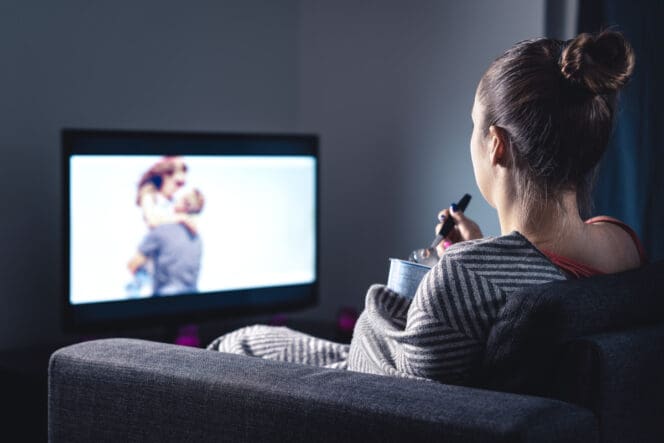Can I Watch TV After LASIK? What About on My Computer or Phone?
LASIK surgery can make your eyes sensitive to light in the initial stages of recovery. This can make the light coming off screens irritating, although permanent damage is not possible because of this light.

Notably, many patients find TV screens less irritating than smaller devices, such as phones. Regardless, normal screen use can likely resume a few days to a few weeks after your surgery.
Is Avoiding Screens After LASIK Important?
Whether it is important to avoid screens after LASIK depends on the patient and how much screen time they consider normal.
LASIK surgery involves cutting into the eye with a laser. Many patients find that their eyes are sensitive for the first few days after surgery. This can make looking at bright lights painful.
Screens, such as those on TVs, computers, and smartphones, produce significant amounts of concentrated light to show you images. We also often use these devices in dark areas, and that contrast can make the light even more uncomfortable during your recovery.
While permanent damage is not possible from viewing these lights, avoiding these devices for the first day or so after LASIK is often necessary simply for reasons of comfort.
How Digital Devices Affect Your Eyes
Some studies suggest blue light, produced by both the sun and digital screens, can cause permanent damage to your eyes. With that said, the American Academy of Ophthalmology notes these studies had a limited scope.
Researchers have yet to find evidence that blue light can do permanent harm to human eyes. If it can do such harm, it is unlikely digital screens expose us to enough to be substantial compared to the sun.
More important than blue light is the way we use our digital devices. Staring at a screen for a long time can cause a number of issues, including these:
- Headaches
- Dry eyes
- Blurry vision
- Teary or watery eyes
If someone is recovering from LASIK, these issues may be compounded. It’s best to let your eyes rest following LASIK, at least for 24 hours.
After LASIK, moderate vision problems during your initial recovery are common. Common symptoms during recovery include the following:
- Mild eye pain
- Itchiness or general irritation
- Blurred vision
- Dry or bloodshot eyes
- Light sensitivity
- Glare, starbursts, or other visual issues when looking at light
Generally, these issues will resolve in the weeks following LASIK.
However, even mild screen use may cause some symptoms to worsen. As you heal, it’s important you don’t touch or scratch your eyes. Limiting screen use and exposure to bright lights can help you reduce irritation and better suppress the instinct to touch your eyes.
Best Practices for Post-LASIK Screen Time
After LASIK, always talk to your doctor about the next steps they advise to support your recovery. They can give recommendations specific to you. They will also recommend a schedule of several follow-up appointments, so they can monitor how your eyes heal and your vision stabilizes. Consulting with an eye care professional prior to undergoing LASIK will ensure all your questions are answered, and you have all the instructions and directions you need to set yourself up for a successful procedure. We can help you find a highly rated LASIK surgeon near you.
You may have difficulty using any digital devices for the first two or three days of your recovery. If looking at screens is irritating your eyes, especially if you feel the impulse to touch them, stop using these devices.
A distant screen, and one in a more evenly lit space, is likely going to be easier on your eyes than a closer screen. This makes phones most likely to cause irritation.
After LASIK surgery, your vision can take three to six months to stabilize. While significant sensitivity to light may disappear in a few days, you may have some symptoms related to light during this stabilization period. Despite these possible symptoms, you can likely handle moderate use of devices such as TVs and computers within a week or so.
At no point is it normal for screen use to cause severe pain or serious vision impairment after LASIK. If you experience these symptoms, contact your surgeon’s office right away.
Tips for Watching TV After LASIK
Watching TV is one of the first types of screen use most LASIK patients can handle. If you want to watch TV, try setting the lights in the room so the room is evenly lit.
If possible, avoid watching content with significant shifts in color. Dark content, like movies set at night, may cause problems as you focus your eyes more to catch small details.
Another useful tip is following what experts call the “20-20-20” rule. This simple rule helps reduce eye strain by having you look away from any screen every 20 minutes. Stare at an object 20 or more feet away, and count to 20.
Some devices have settings to reduce the irritation their screens can cause. Often called “night mode,” this setting can change the light the screen puts out, so it puts less strain on your eyes.
In the days following LASIK, consider setting your phone or computer to default to this mode. You can then switch it back once your eyes have stabilized a bit.
References
-
Digital Devices and Your Eyes. (January 2022). American Academy of Ophthalmology.
-
LASIK. (March 2018). U.S. Food & Drug Administration.
-
What Should I Expect Before, During, and After Surgery? (July 2018). U.S. Food & Drug Administration.
Last Updated May 22, 2024
Note: This page should not serve as a substitute for professional medical advice from a doctor or specialist. Please review our about page for more information.